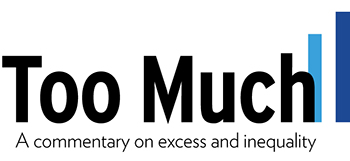Editorial writers at the Wall Street Journal are still celebrating George W.’s tax cuts, but the Presidential campaign’s first debate on tax policy has just helped expose who really gains when tax cuts tilt to the top.
By Sam Pizzigati
The ideologues who manage the Wall Street Journal’s editorial pages have emerged, over recent years, as America’s most unrelenting — and shameless — defenders of wealth and privilege. They enjoy the work. They do it well. No one turns reality upside-down any better.
Take, for instance, the Journal editorial last week that defended George W. Bush from charges that his administration tilts to the wealthy. George W.’s tax policies, the Journal pronounced, have actually “caused what may be the biggest increase in tax payments by the rich in American history.” Any Bush “giveaway to the rich,” the Journal editorial added, exists only as “a figment of the left’s imagination.”
 The Journal offered some evidence for these bold assertions. According to just-released IRS statistics, the paper noted, America’s richest 1 percent paid 40 percent of all income taxes in 2006, their “highest share in at least 40 years.”
The Journal offered some evidence for these bold assertions. According to just-released IRS statistics, the paper noted, America’s richest 1 percent paid 40 percent of all income taxes in 2006, their “highest share in at least 40 years.”
Case closed? Not quite. The rich, as a group, are indeed paying a larger share of the nation’s income tax dollars, but only because they’re pocketing a much larger share of the nation’s income. As individuals, the IRS data show, the rich are actually paying less — far less — of these incomes in taxes than they have in years.
In fact, if average taxpayers in the top 1 percent had paid taxes in 2006 at the same rate as the top 1 percent paid taxes 20 years ago in 1986, those average top 1 percent taxpayers would have each paid $136,518 more in 2006 taxes than they actually did.
What do the McCain and Obama campaigns feel about this top-tilting tax status quo? Both campaigns had a chance to explain last week in the nation’s capital, at the 2008 Presidential race’s first debate devoted purely to taxes. The host for the event: the Tax Policy Center, a joint project of the Urban Institute and the Brookings Institution, two bedrock pillars of the capital’s policy wonk community.
Tax Policy Center researchers last month published a preliminary analysis of just how the McCain and Obama tax plans would likely play out. The researchers unveiled an updated analysis at last Wednesday’s debate, 56 dense pages of numbers and charts.
But one set of numbers stood out in that numerical mass: the Tax Policy Center’s comparison of which Americans would pay more in taxes under the McCain and Obama plans and which would pay less.
Under the McCain plan, the Tax Policy Center figures indicated, Americans in the top 0.1 percent — that’s everyone making at least $2,871,682 — would average $192,645 less in taxes in 2012 than they would if the current tax situation were simply extended.
After-tax incomes for the top 0.1 percent, if the McCain tax plan became law, would jump five times faster than after-tax incomes for taxpayers in the middle of the U.S. income distribution and 15 times faster than average incomes for the poorest fifth of Americans.
Under Obama’s tax plans, the top 0.1 percent would pay more in taxes, not less — an average $788,959 more. Middle- and low-income Americans, by contrast, would see sizeable tax cuts. These cuts, according to the Tax Policy Center analysis, would save Americans in the middle almost four times more than the savings they would see from the McCain plan. Poor Americans would save 30 times more under Obama than McCain.
At last week’s debate, Obama’s lead expert — University of Chicago economist Austan Goolsbee — spoke first. Not surprisingly, Goolsbee welcomed the Tax Policy Center numbers. McCain’s tax plan, he energetically charged, would “magnify” the “regressive” legacy of the George W. Bush years.
Onlookers in the packed Urban Institute meeting room then hunched forward for the McCain campaign response — from Douglas Holtz-Eakin, a former White House Council of Economic Advisers chief economist.
Would Holtz-Eakin blast the Tax Policy Center for propagating misleading information? Would he try to deny that the lion’s share of the tax savings from the McCain plan would go to taxpayers at the top of the nation’s economic ladder? He would not.
Holtz-Eakin made no challenge whatsoever to the Tax Policy Center’s numbers on the distributional impact of the McCain tax plan. He simply ignored them — and orated instead on “what John McCain is trying to accomplish” with his tax proposals. And what’s that? McCain’s plans, Holtz-Eakin asserted, focus on “creating jobs and economic growth.”
That sound familiar? Here’s why: The Bush White House used the exact same rationale, back in 2001 and 2003, to justify its tax cuts for the wealthy. But don’t credit George W. with any originality on that score. Two decades earlier, in 1981, Ronald Reagan made the same case — that tax cuts for the rich bring an economic growth that benefits everybody.
Ronald Reagan’s tax cuts and George W.’s tax cuts delivered nothing of the sort. These cuts didn’t “grow” a healthy economy. They merely grew the wealthy’s share of America’s economic pie. And they didn’t just grow the wealthy’s share of that pie. They doubled it.
In 1986, this month’s newly released data from the IRS document, America’s top 1 percent collected 11 percent of the nation’s income. In 2006, these top 1 percent taxpayers took home twice that share, 22 percent.
In sum, tax cuts for the wealthy clearly work. For the wealthy.
Sam Pizzigati edits Too Much, the online weekly on excess and inequality published by the Washington, D.C.-based Institute for Policy Studies.



Discussion
No comments for “McCain and Obama Surrogates Go Mano a Mano on Taxes”